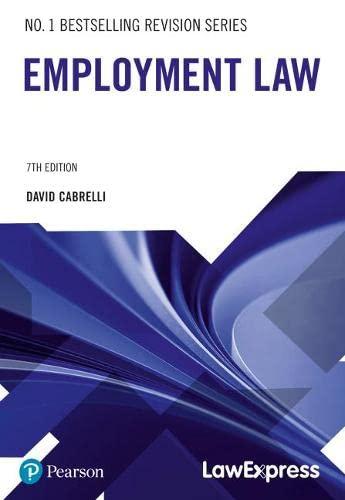Question
SECTION A Oppenheim v The White Lion Hotel Company, Limited Court of Common Pleas Willes, Keating, and Montague Smith, JJ. 1871 June 23 (1870-71) L.R.
SECTION A Oppenheim v The White Lion Hotel Company, Limited Court of Common Pleas Willes, Keating, and Montague Smith, JJ. 1871 June 23 (1870-71) L.R. 6 C.P. 515 The plaintiff, a traveller, went to a large hotel in Bristol, arriving at 11 P.M. In the commercial room he took from his pocket a canvas bag containing 22 in gold, some silver, and a 5 note, and took out some small change to pay for some stamps. He did not exhibit his money, nor mention to anyone that he had any money in his possession, but, about five minutes before he went to his bedroom, simply took out the canvas bag from his pocket and took 6 pence from it to pay for some postage-stamps. He then replaced the bag in his pocket. He was then shown to a bedroom on an upper floor, the door of which had a lock and a bolt, and the window of which looked out on to a balcony. He was cautioned by the chambermaid that the window was open, but nothing was said about locking the door. There was no notice in the plaintiff's room requiring guests to lock or bolt their doors; nor had the plaintiff seen any such notice in any part of the inn; nor was he told by any of the defendants' servants that guests were required or advised to lock or bolt their doors. The plaintiff, in giving his evidence, stated that he was generally in the habit of locking his bedroom doors when sleeping in an inn, but he had not done so on the occasion in question. On going to bed he closed the door, but did not lock or bolt it, although the bolt and lock were both in good order and a key was present. After the plaintiff entered his bedroom he closed the door, proceeded to undress, and placed his trousers on a chair by the side of his bed, on the side farthest from the door, and in such a position that any one entering the room would have had to go round the bed to get to the chair. The bag of money was in the pocket of these trousers. The plaintiff then went to bed without having locked or bolted the door of the room,the door remaining shut. Section A continued The plaintiff got up at 7 o'clock the next morning. The door of the room was then shut. The plaintiff then saw lying on the floor of his room some bits of paper and a small toysample, which had been in the trousers pocket in which the money was. The pocket of the trousers was turned half out, and the bag with the money contained therein was not in the pocket, nor to be found in the room. The plaintiff communicated his loss to the manager of the hotel, who sent for detectives, but nothing was discovered. Some person had during the night stolen the money; that such person could not possibly have entered by means of the window of the bedroom; and that the robbery could only have been effected by a person entering the plaintiff's bedroom by the door. This case was an appeal from the Gloucestershire County Court where the judge, in summing up the case to the jury, first explained to them the law as to the liability of innkeepers for the safe custody of the property of their guests, and then told the jury that the question for their consideration was whether the loss would or would not have happened if the plaintiff had used the ordinary care that a prudent man might reasonably be expected to have taken under the circumstances. The jury found in favour of the Hotel. HELD - Held, that the direction by the judge in the County Court was correct and the verdict of the jury was also correct. text courtesy of Westlaw and the Crown QUESTION 1: ANSWER ALL PARTS OF THIS QUESTION: a. What is the current law on defences to negligence where the injured person is at fault? b. Using the current law, explain whether a defendant can use a clear and well-timed disclaimer to exclude liability for negligence? c. What do you think the result might be if the current law you have just described were to be applied to the Oppenheim case?
Step by Step Solution
There are 3 Steps involved in it
Step: 1

Get Instant Access to Expert-Tailored Solutions
See step-by-step solutions with expert insights and AI powered tools for academic success
Step: 2

Step: 3

Ace Your Homework with AI
Get the answers you need in no time with our AI-driven, step-by-step assistance
Get Started


